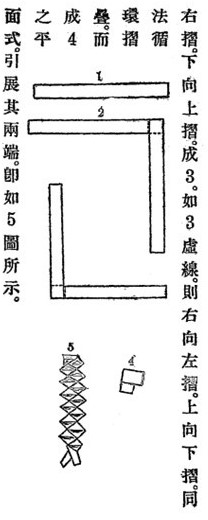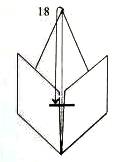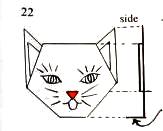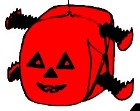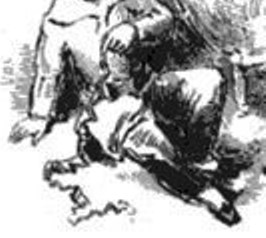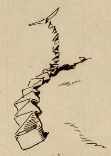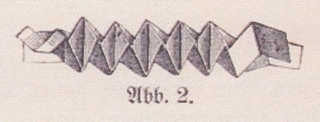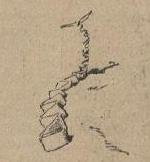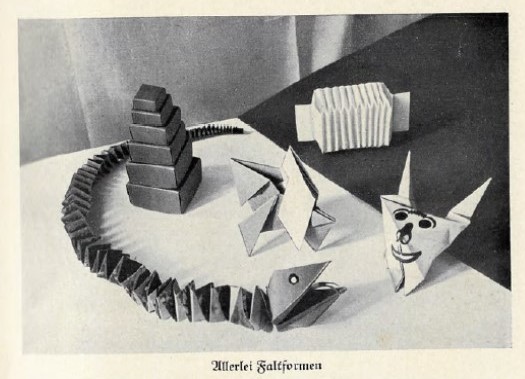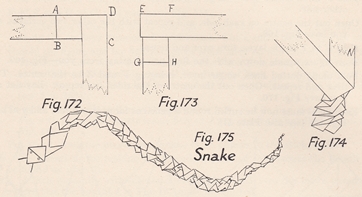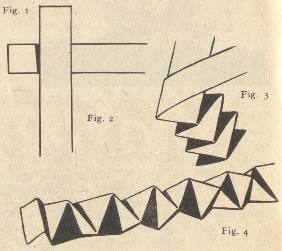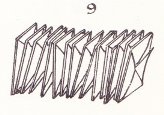| The Public Paperfolding History Project
Last updated 18/11/2025 x |
|||||||
| The Witch's Ladder / Devil's Staircase / Hexentrappe / Harmonika / Muizentrappe | |||||||
| This
page is being used to collect informaton about the
history of the design known in English as the Witch's
Ladder or the Devil's Staircase, in German as Hexentreppe
or Harmonika and in Dutch as the Muizentrapje. Please
contact me if you know any of this information is
incorrect or if you have any other information that
should be added. Thank you. It is possible that this design was originally folded from palm leaf fronds, although I have not been able to ind any references to verify this theory. ********** In China (and in publications by Chinese authors) 1917 The design appears as 'Paper Chain' in 'Xu Zhe zhi tu shuo' (More Illustrated Paperfolding) by Yongxiang Shi, which was published by the Commercial Press in Shanghai in 1917.
********** In Japan (and in publications by Japanese authors 1965 'Origami in the Classroom: Book 1: Activities for autumn through Christmas' by Chiyo Araki, which was published by Charles E Tuttle Co Inc in 1965, contains diagrams for a cut 'Pussy Cat' whose body is a Witch's Ladder.
*** Witch's Ladders are also added as arms to a Waterbomb to produce a Jack O'Lantern.
********** In Europe and the Americas 1855 There is an illustration of a child playing with a folded strip of paper, which is possibly a Witch's ladder, in 'Woman's Educational Mission: Being an Explanation of Frederich Froebel's System of Infant Gardens', by Baroness von Marenholtz, translated into English by Elizabeth, Countess Krockow von Wickerode, which was published by Darton and Co in London in 1855.
********** 1863 A much clearer illustration can be found in 'De Kleine Papierwerkers: Volume 2: Wat men uit strookjes papier al vlechten kan' which was published by K H Schadd in Amsterdam in 1863. As far as I can tell theillustration is not referred to in the text.
********** The design also appears: 1873 In 'Exercices et Travaux pour les Enfants Selon la Méthode et les Procédés de Pestalozzi et de Froebel' by Fanny and Charles Delon, which was published by Librairie Hachette in Paris in 1873.
********** As 'Katzentreppchen' (cat staircase) in 'Die Praxis Des Kindergartens' by August Koehler, which was published by Herman Bohlau in Weimar in 1873. The text says that this design is folded from two strips and so despite the strangeness of the illustration I believe it is the Witch's Ladder.
********** As 'Katzentreppchen' (cat staircase) in 'Der Kindergarten: Theoretisch-Praktisches Handbuch' by A S Fischer, which was published by Alfred Holder in Vienna in 1873.
********** 1875 As 'De slakkenhuisjes' (the snail shell) or 'Het wentel trapje' (the spiral staircase) in 'Froebels Methode' by Elise Van Calcar, which was published in 1875.
********** 1882 In Part two of 'The Kindergarten Guide' by Maria Kraus Boelte and John Kraus, which was probably first published by E. Steiger and Company in New York in 1882, where it is called the 'Fairy Steps'..
********** 1883 A drawing of the Witch's Ladder as a worm appears in a pictorial story by Apeles Mestres dated 2nd August 1883 found in his Llibre Vert III.
********** The Witch's Ladder is mentioned, under the names 'les serpents ou les accordeons' in the 17/1/1883 edition of the Journal de Instituteurs. The third paragraph of the right hand column says, roughly, 'The folding of two strips of paper of different colours, serpents or accordions as children call them, which we have all made under the instruction of out grandmothers, allows numerous observations on numbers, on lines, on the triangle, the square etc.' ********** 1884 The design also appears in 'Jeux et Jouet du Jeune Age' by Gaston Tissandier, which was published by G Masson in Paris in 1884.
********** 1886 In the second ediion of 'Des Kindes Erste Beschaftigungsbuch' by E Barth and W Niederley, which was pulished in 1886.
********** 1889 The design appears as 'L'Accordeon ou Serpent' in 'Jeux et Travaux Enfantins - Première partie: Le Monde en Papier' by Marie Koenig and Albert Durand, which was published by Librairie Classique A. Jeande in Paris in 1889.
********** 1891 There is a reference to an escalier de souris (Mouse stair), which I take to be a possible reference to the Witch's Ladder, in the 'Bulletin de la Societe de Protection des Apprentis', an official document issued by the Societe de Protection des Apprentis et des Enfants Employes par les Manufactures in Paris in 1891. ********* 1896 There is reference to 'Pussy-cat stairs' in part 2 of 'The Republic of Childhood', titled 'Froebel's Occupations', by Kate Douglas Wiggin and Nora Archibald Smith, which was published by Houghton, Mifflin and Company, of Boston and New York in 1896.
********** The design also appears: 1908 In the last ever issue of the Catalan satirical magazine 'La Campana Catalana', published in Barcelona on 29th April 1908, in a cartoon by Apeles Mestres which pictures a variety of paperfolding designs, including a Witch's Ladder in the form of a worm. This pictorial story had previously been published in his Llibre Vert III in 1883.
********** 1910 As 'Ziehharmonika' (accordion) in Part 2 'Das Flechten' of 'Die Frobelschen Beschaftigungen' by Marie Muller-Wunderlich, which was published by Friedrich Brandstetter in Leipzig in 1910.
********** Mention of the Witch's Ladder, under the name of 'Jacob's Ladder', and used to make handles for May Baskets, occurs in 'Studies in Invalid Occupation' by Susan E Tracy was published by Whitcomb and Barrows in Boston in 1910 ********** As 'Cat-Stairs' in 'Educational Handwork' by T B Kidner, which was published by The Educational Book Company Limited in Toronto in 1910. Description only, no illustration.
********** 1913 In 'Trabajo Manual' by C Champy Alvear, which was published by Cabaut y Cia in Buenos Aires in 1913.
********** 1923 In 'Trabajos Manuales y Juegos Infantiles' by Francisco Blanch, which was published by I. G. Seix y Barral Hermanos S.A.- Editores in Barcelona in 1923. About this design the text says, 'In the same way that we build worms with palm leaves, we can make them with strips of paper'.
********** 1931 As 'Herrenstiege' (Men's Stairs) in the revised 3rd edition of 'Lustiges Papierfaltbüchlein' by Johanna Huber, which was published by Otto Maier in Ravensburg, Germany in 1931. The rings are made by stiffening the woven strips with wire.
These strips are also used as the basis of models of: Eidesche - Lizard
*** Igel - Hedgehog The spikes are toothpicks.
*** Katze - Cat
********** 1933 A 'True Lover's Knot' made from two long strips of paper or straw folded into a Witch's Ladder appeared in 'Diversions and Pastimes' by R M Abraham, which was first published by Constable and Constable in London in 1933.
********** 1936 The design appears as 'Schlange' (Snake) in 'Allerlei Papierarbeiten' by Hilde Wulff and Carola Babick, which was published in Leipzig and Berlin in 1936. It is combined with the (Cut) Paper Snapper to make a snake.
********** 1937 A snake made from a Witch's Ladder appears in 'Paper Toy Making' by Margaret Campbell, which was first published by Sir Isaac Pitman and Sons Ltd in London, probably in 1937, although both the Foreword and Preface are dated 1936, which argues that the book was complete at that date.
********** The design also appears: 1939 In 'Plegado' by Rufino Yapur, which was published by Editores Independencia in Buenos Aires in 1939.
********** 1949 As a way of making a decorative 'Guirlande' (Garland) in 'Au Pays des Mains Agiles', which was published by Editions Fleurus in Paris in 1949.
********** 1960 As 'The Concertina' in 'Paper Folding Fun' by Robert Harbin, which was published by Oldbourne in London in 1960.
********** 1961 As 'Faltgirlande' in 'Wir Falten' by Joachim Schönherr and Gerta Schumann was published by Rudolf Arnold Verlag in Leipzig in 1961. In the same work the Witch's ladder is also used as the body of a snake. ********** |
|||||||
